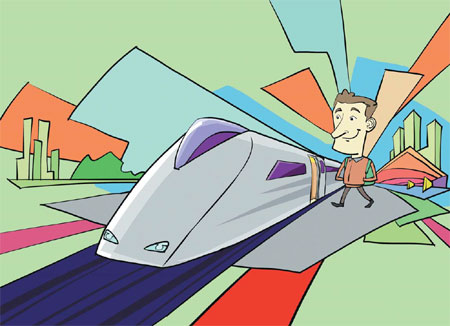Taking China's measure by fast train


A trip to a world where many Chinese don't just become consumers, but world citizens
I am in the middle of the Chinese countryside, somewhere between Changsha and Wuhan, traveling north at 300 kilometers per hour on a G-train - the fastest high-speed EMU bullet train in China. The electric multiple unit train has self-propelled carriages.
I don't feel like I'm traveling very fast, because the ride is quite smooth, without the swaying you find on the French high-speed TGV ("Tres Grande Vitesse" or very high speed train), or the Eurostar, which runs at high speed from London to Paris under the English Channel. China's new high-speed train has obviously taken advantage of the massive technological improvements since the 1980s and 1990s, when the TGV and Eurostar were built.
I am sitting in the last carriage, and I walk through the train to the front. There are 15 carriages, making the train almost a half-kilometer long. Ten carriages contain economy class passengers, each with 75 seats. All are full. Three more carriages contain first-class, where I sit. These are nearly full. There's a restaurant car, and one carriage in the middle of the train with the "business class" seats, which you can slide down to a horizontal position for sleeping. Mostly full as well.
There are seats for 999 passengers altogether. Almost all are occupied, and only four passengers on the train are foreigners. Six trains a day, seven days a week, 52 weeks a year - well over a million passengers from south to north every year, and the same the other way, on only one of the high-speed rail routes in China. There are a lot of people moving at high speed across China every day.
We reach Wuhan, and enter another enormous railway station, standing outside the town, with lots of high-speed trains drawn up like horses in their stables, waiting to go somewhere. An attendant brings us our lunch. For 30 yuan ($4.80, 3.70 euros), you get a plastic tray with lots of rice, plus tofu, peas and carrots, mushrooms - all vegetables. We asked for meat, but it was all gone by the time the attendant reached us, sitting in the final row in the last carriage. Still, it's perfectly edible, and we got a free bottle of water.
The train starts to move and we ease out of the station, gathering speed quickly. Soon we leave Wuhan, and outside the window I can see the Yangtze River underneath the train, as we pass over a long bridge, heading north. We enter one tunnel, then another, and I can feel the train tilt uphill a little. Outside, the flat rice paddies have given way to hills and valleys. We pass through more tunnels. How much did this cost to build, I wonder?
Beside me sits my Chinese wife, Ying. We remind ourselves that the first time we traveled together in a Chinese train was in 1988, from Beijing to Shanghai, at 60 kph, a 24-hour journey. Today, you can travel by train from Guangzhou to Beijing in eight hours. That's a stunning example of China's development over the past 25 years.
America seems to be able to do fine without high-speed trains, while France, proud of its TGV, doesn't seem to be going anywhere. So should China have spent all those billions of yuan on the biggest high-speed train system in the world? True, they're a convenient way to get from Guangzhou to Beijing in eight hours. It's much easier passing through security in a Chinese railway station than in a Chinese airport. Once in the carriage, the seats are comfortable and you can walk around, and watch one Chinese province after another flash by through the window. I was about to add that trains aren't subject to weather delays, but my wife had told me that the first leg of this May journey, from Shenzhen to Guangzhou, was cancelled because of a mudslide on the track, after the endless torrential rain of the previous fortnight in southern China.
But it's only a little cheaper travelling economy class on a G-train than it is by plane. Is the payoff enough to justify the enormous cost of building the Chinese high-speed network? Is linking Beijing closer with Shijiazhuang, Zhengzhou, Wuhan, Changsha and Guangzhou really that important?
Many studies have shown that improving communications is one of the biggest single things you can do in a country to broaden and accelerate economic growth. In a country the size of China - one of the world's largest - the social and economic returns to high-speed transport are even more significant than they are in a small country, like Holland or the United Kingdom. Better communications also help to limit or reverse the downside of China's development since 1980, the sharp rise in economic inequality.
We've stopped going uphill and passing through tunnels. Outside the window, there are not many villages. The hills north of Wuhan have stopped and the train is traveling through flat rice-paddies, still at 300 kph. The fields are more orderly, the trees are much taller and there are a lot more of them. The outside temperature in Wuhan was 32 C, according to the electronic monitor in our carriage. Here, the temperature is the same, but sunny and drier. All the Chinese in our carriage are taking their after-lunch nap. Even my wife, who is from Beijing, has her eyes closed. Before she went to sleep, she was telling me about an article she was reading about Chinese Internet development, still dominated by the Big Three (Baidu, Alibaba and Tencent). But, according to the article, that's going to change in the next few years, as Chinese e-commerce expands and the volume of mobile Internet activity mushrooms. While she talks, I think to myself that high-speed trains and mobile Internet are related. They're two areas that have succumbed to the intense pressure of China's demand to develop and modernize. Now China's becoming a world leader in both.
Where will this end up, I wonder, as through the window I watch Hebei province become Henan. Where are we going? All we know is that we're on a journey to a world in which many of the 1.3 billion Chinese people don't just become consumers, but world citizens, with passports that take them to New York, Paris, Rio de Janeiro, Capetown and everywhere else. And, like my train to Beijing, it's happening at 300 kph.
Soon we arrive at Zhengzhou. The rice paddies have been replaced by fields of half-grown grain. Last time I came on this route, in the late 1990s, you could see across the plain for miles. Now, there are lots of trees, holding the dusty soil in its place. By the time we reach Shijiazhuang, the countryside has become populated, with lots of small villages surrounded by well-cultivated fields. It takes 20 minutes to pass through the outskirts and suburbs of Beijing before we arrive at Beijing West station, right on time at 6 o'clock, eight hours after we left Guangzhou South.
The Guangzhou to Beijing high-speed train is a marvel of engineering and passenger comfort - a high-speed rail line of over 2,294 kilometers, about the same distance as a round-trip journey from Paris to Venice. But, looking out of the window, one can see a China that remains mostly undeveloped. China has come a long way. But it still has far to go.
The author is a visiting professor at Guanghua School of Management, Peking University. The views do not necessarily reflect those of China Daily.

(China Daily Africa Weekly 10/10/2014 page11)
Today's Top News
- Unified national market a new growth launchpad
- US deal a structural challenge for Japan
- Industrial prowess of China a subject of serious study
- US new tariffs 'unfair': Experts
- NDRC recalibrating steps to drive growth, boost demand
- Wartime hero's legacy fortifies Sino-UK bond






























